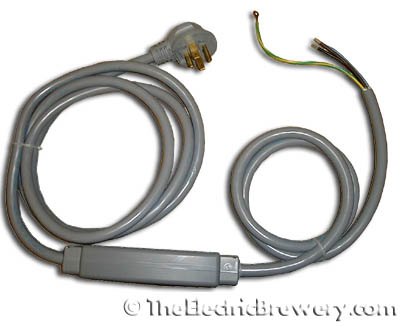A standard breaker will most certainly not have GFI protection built in. In the US, many breakers now require arc fault protection so you'll see newer houses with lots of those, but that's something completely different.
Regular breakers are rated for specific current ratings and will switch off (or 'trip') if ever the rated current is exceeded on the circuit they control. The sole purpose of breakers is to protect the wires from overheating.
A GFI (or more accurately, a residual-current device) on the other hand is not used to protect wires or devices - it protects the equipment operator. A GFI will cut power when it detects that the current going in to a circuit does not match the current coming out of the circuit. Often this imbalance (typically only a few milliamps) is caused by current leakage through the body of a person who is grounded and is accidentally touching an energized part of the circuit.
The distinction is important: A circuit breaker saves equipment, a GFI saves lives. GFIs are designed to prevent electrocution by detecting the leakage current, which can be far smaller (typically 5–30 milliamperes) than the currents needed to operate conventional circuit breakers or fuses (several amperes).
Hi I am planning on making a very simple keggle. I have a 5000w hot water heater element. Will be attaching to 15gallon Sanke Keg, (my current brew pot) and plugging element into stove or dryer to the outdoors.
My question is this: Can I do this without a control panel? I really just need it to bring the wort to a boil and hold it for 1.5 hrs. For me simpler is always better, as long as it works.
Most certainly you can do this.
You can power the heating element directly but keep in mind that you may need some way to throttle power (otherwise it'll be on 100%). Since you're only boiling then running it 100% may be fine if your volume of beer is adequate for the element size: A 5500W heating element is good for boiling 8-20 gallons or so, or possibly more (depending on kettle configuration/insulation, ambient temperature, use of a kettle chimney, etc.). If boiling less, I'd use a 4500W heating element instead.
If you use a ultra-low-watt-density (ULWD) there will not be any problems with caramelization in the boil due to over vigorous boiling. The worse thing that will happen is that you simply boil off too much water if the element is too powerful for the amount of wort.
You should however have a way to turn the heating element on/off. Plugging it in/unplugging it is not a safe way to turn it on/off as there is a large amount of current that runs through the element. You should really have some sort of switch that is meant to handle 240V/30A for both the 4500W or 5500W element. A simple way to do this is to use a sub-panel breaker box off the main breaker panel, located near where you're using the heating element so it's easy to turn on/off. You would use a 2-pole GFI breaker rated for 240V/30A in this sub-panel breaker box as the switch to switch the 4500W or 5500W element on/off. (I know some brewers do simply plug them in/out to turn the heating elements on/off, but I feel it best to let people know the proper safe way to do things whenever possible).
For heating to specific temperatures such as is done in a Hot Liquor Tank however, there is no simple way to do this with without a control panel of some sort. Turning the element on/off periodically to try and maintain a specific temperature is not only very difficult but will grow tiresome after a few hours. You don't mention needing that but I thought I'd point it out anyway.
Good luck!
Kal




